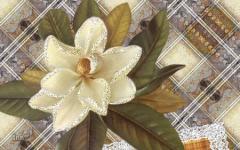The decorative rose is becoming more and more popular in home flower gardens. And this despite the fact that roses in pots are very capricious flowers. They require constant attention better conditions, non-observance of which will lead to the loss of flowers and diseases of the plant.
A room rose has several differences from a street one - it is more compact in size and more whimsical, caring for it is not difficult, but it requires all conditions to be met. Flowers may be different colors, and rare thorns are located on the stem. If the care of the rose meets all the requirements, then they can bloom all year round. After buying a flower in a store, you should not immediately transplant it. The plant must get used to the new climate and take root. There are some other features of the content of the rose.
The rose is transplanted for the first time after purchase. But from the moment of purchase to the transplant, time must pass for the plant to get used to the new conditions. In the process of keeping a rose, it will need to be replanted every two or three years. Transplantation is recommended lunar calendar when the moon rises. To properly transplant roses, you need to follow the recommendations.
- The plant needs to be transplanted by transshipment. This method allows you not to injure the delicate root system. To cross the plant, you must first remove earthen clod from the pot, after tapping on its walls.
- It is not necessary to clean the roots from the ground. You can remove the top layer and loosen the earthen lump.
- Soil preparation. To do this, mix four parts of soddy land and humus with one part of sand.
- Pot selection. The pot must have a drain hole. If you use a pot in which another plant was previously grown. Then it must be thoroughly washed with a brush. A layer of expanded clay or gravel is poured into the prepared pot as drainage. Then pour some soil. The plant, together with an earthen clod, is placed in the middle of the pot and the remaining free space is sprinkled with earth.
- After planting, the plant needs more attention and more thorough care at first. First, it is removed in the shade. Even a room or window sill with a northern orientation is suitable for this.
- A day later, the pot with the plant is transferred to a lighted place, it is possible to a balcony or window sill. But there should be no drafts in the room, although fresh air is needed, and the rays of the sun are not allowed on the rose.
If you follow all the recommendations for transplanting, then the plant will quickly take root in the new conditions and the appearance of luxurious flowers will not have to wait long.
Rules for keeping a room rose
The first time after buying a rose, she needs to create conditions similar to those in which she was previously kept. If the flower pot was in a bright place, then you need to find the same in the apartment, and also create similar temperature conditions and air humidity. Such measures are necessary only for the first time, so that the plant tolerates the change of residence well and does not die. Then he will need the usual care recommended for roses. To properly care for roses and keep them in order, you must adhere to the following rules.
Watering
You need to water the rose when the topsoil dries out. If the days are hot, then the flower may need two waterings. Water should be used only clean, after it has settled well. You need to pour it under the root and choose a time of day when it is less hot.
The lack of moisture is immediately manifested by the drying of the leaves.

Feeding
Indoor rose responds positively to top dressing. It is recommended to fertilize twice a month when it is actively growing. You can water with mullein or use mineral fertilizers. For foliar spraying, fertilizers in solutions are used. Sick plants and those that have recently been transplanted do not need to be fed.
Lighting
Proper care of plants consists not only in watering and feeding, but also in choosing a good place for the plant. spray rose loves bright lighting. And the best place for her at home would be a window facing south or southwest. From this side the sun shines from morning until sunset. The north and east windows are not suitable for roses, the lighting on these sides is insufficient, and the daylight hours are short. In the autumn, when the sun becomes not so bright, and the daylight hours decrease, roses can be illuminated with artificial light. The same technique can be done in the spring, to improve the vegetation of plants.

Humidity
In order for flower care to be correct and effective, we must not forget about the level of humidity in the room. If the apartment has dry air and high temperatures, then the plants need to be sprayed. In the summer they are taken out to the balcony or loggia, where they will be much better.
Diseases and pests
The most common pests on roses are spider mite and To prevent their occurrence, we need not only proper care but also regular inspection of the plant. When a mite appears, the most noticeable sign is the webs on the underside of the leaves. The insects themselves are so small that when they become noticeable, the plant is already badly damaged. The mites feed on the sap of the plant and leave small, pale spots behind. Aphids are more visible, they also feed on sap and settle on stems and leaves. best with insecticides. They are the most effective and allow you to destroy the pest several times.
They appear mainly when the necessary care of the plant is not observed. The most common diseases are rust and black spot. When they appear, spots form on the leaves, then they curl and fall off. The reason for their development is waterlogging of the soil and cold. You need to fight diseases with the help of fungicide preparations.
In order for the roses to bloom as long as possible, it is necessary to provide the conditions in which the buds will be laid. And the better these conditions, the more kidneys are formed. To do this, you need to provide the plant with a full rest period, that is, stay in a cool place with a temperature of 15-17 degrees Celsius. All stems are cut off. In order for new buds to form faster, you need to take care of the rose, removing old faded buds and dry twigs.

Rose breeding
For propagation, twigs obtained by pruning the plant are used. Of these, you need to cut several cuttings, each should be at least 15 cm long and have 3-4 buds. The resulting cuttings are placed in clean water for rooting. After about two weeks, the first roots will appear. You need to wait until they grow up and plant the cuttings in small pots.
You need to care for cuttings in the same way as for adult plants.
House roses are loved for their beautiful blooms, but in order for them to bloom as long as possible, the plant needs careful care. And although caring for roses is not difficult, there are still certain nuances. They do not tolerate dry air, watering cold water dried buds, leaves and twigs left on the bush. Wintering at high temperature also not suitable for roses, and of course, like all plants, roses do not tolerate the presence of pests.
How to care for bulbous houseplants How to care for indoor, medicinal varieties and types of aloe (agave)
Add site to bookmarks
A beautiful decorative rose is a home decoration
- Expert advice on planting and transplanting roses
- We provide the plant with normal conditions for growth
- How to care for a delicate and fragrant rose?
Luxurious decorative rose attracts attention, and also attracts with its charming beauty and unique aroma. In order for the plant to develop properly, it is necessary to properly care for it.
For full growth and development, decorative roses require abundant watering, top dressing and timely transplantation.
Today there is simply a huge amount various kinds decorative roses. However, their care is almost the same. Therefore, using general recommendations, you can help the home rose to develop properly and bloom very beautifully. In order for such a beautiful plant to take root faster in an apartment or a country house, it will not take too much effort. It is enough to properly feed and water it and, of course, transplant it in time.
Expert advice on planting and transplanting roses

A decorative rose is best transplanted into pots made of clay.
Many owners of home plants recommend placing a pot of roses on the southern windows. In late spring and summer, the flower can be taken out into the air, which will be very useful for him. For a home beauty, you need to choose the right soil, which should be filled with nutrients. It should be remembered that an ornamental rose is a very demanding plant. However, there is no need to be afraid of this, since satisfying his numerous whims is quite simple.
It is best to plant and transplant a plant on a growing moon. Many are sure that in this case it will grow much faster. If the flower was recently purchased, then there is no need to hurry too much with the transplant. The plant in the pot should get used to the new room.
In specialized stores, you can buy soil that is 100% suitable for roses. Therefore, it is best to use it, since such a soil mixture has all the necessary nutrients that the flower needs. During the transplant, you need to remember about the drainage, which is 1 cm. All work must be done very carefully so as not to damage the rhizome.
To perform a proper rose transplant at home, you need to take a pot that has a larger volume than the previously used container. It is best to opt for a pot that was made of clay. Before transplanting, the rose should be well watered. Only after that the bush can be taken out and transplanted. Watering is not recommended. However, you can spray the leaves. It is best to put the pot in the shade, and the next day move it to its original place. After about 30 days, the flower needs to be fed a little.
Back to index
We provide the plant with normal conditions for growth

So that the plant does not suffer from overheating and overdrying, a shower for a room rose should be carried out once a week.
In order for a luxurious decorative rose to develop correctly, it is imperative to provide it with the most optimal growing conditions. For example, this plant loves light very much. That is why it is best to put the pot on illuminated windowsills. However, in summer, the rose, which is located on the south window, can simply die from the heat. In winter, the room where the flower is located should be cool.
Most often, roses suffer from overheating and overdrying.
If the air in the room is too dry, then the leaves of the plant will begin to dry very quickly, and pests can attack it. To prevent this, every day it is necessary to carefully spray the leaves with clean water. On the balcony, this procedure is done a little less often.
But in winter, flowers can die very quickly from the fact that the rhizome is simply supercooled. To prevent such a nuisance from spoiling the plant, it should be protected from drafts.
Just once a week, you should take a shower for a room rose, which will be very useful. After this procedure, it is necessary to loosen the earth. It should be done very carefully, as the rose has a very delicate root system. For this plant, a mixture of sand, humus and soddy soil is 100% suitable.
It is known that the rose is a rather capricious plant. She constantly needs attention and care, she does not tolerate drafts and sudden changes in temperature. If you run it, then the beauty will die, but if she organizes good conditions for life, she will delight you with beautiful buds throughout for long years.
A decorative indoor rose differs from its garden sister in smaller sizes and more whimsical. In color, it can be yellow, pink, red. As a rule, the rosette has a thin stem and rare sharp thorns. If you properly care for her, then she will be able to produce inflorescences almost all year round.
Once you have purchased the treasured flower pot, do not rush to transplant the plant into another container. Let the rose get used to the microclimate of the apartment, take root. After a while, it can be transplanted into a pot a little bigger size than the previous one. Remember that the rose does not like sudden changes in the size of the pots, and therefore you can not immediately move it from a small to a spacious box. By the way, it is best to transplant a flower in the fall. When carrying out the procedure, make sure that the clod of earth does not crumble and does not injure the root system.
Watering indoor decorative rose recommended as the soil dries up. As a rule, the interval between watering is 2 - 3 days. The water should not be cold. Room temperature is optimal. It is also advisable to use settled water for irrigation. Twice a year it is recommended to reinforce the flower with special fertilizers for indoor plants. The solution must be gentle.
Do not forget at least once a month loosen the earth, this gives the flower additional oxygen, allowing it to breathe and develop. Know that this tender plant loves moisture, and therefore tolerates spraying with clean water well. Ventilate the room regularly, but at the same time, do not put the rose in a draft, otherwise it will quickly wither.
try to the best of my ability thin out vegetation. Ideally, as soon as the bud has faded, it should be cut off along with the stem, leaving a small margin of a few centimeters above the ground for future shoots. Capital thinning of the flower is recommended to be done at the end of autumn.
indoor rose dislikes bright sizzling sunlight. If you want to preserve its beauty for a long time, fence it off with a protective film, while leaving an opening for the sun's rays. The film or foil should not be higher than the buds. So, following the simple rules of care, you can enjoy the beauty of a flower for a long time.
For additional questions about the care of the Decorative room rose, ask through the form below.
- exposure to direct sunlight, as well as low humidity;
- watering with cool water is not recommended;
- the constant leaving of dead plant fragments on the bush;
- damage to the root system;
- wintering in inadequate conditions (temperature above normal);
- ignoring pests and diseases.
Growing and caring for a rose in a pot
Growing a decorative rose comes down to regular care for it. Care, in turn, consists in regular watering, feeding and shaping a bush (pruning).
Rose care in the summer
In the summer, when the indoor rose is developing especially actively, it must be watered regularly, fed in a timely manner, sprayed to wash the leaves and shoots. Care for a room rose in a pot under such conditions should be of high quality and thorough. This approach allows you to save the plant from negative consequences not proper care.
It is very important to regularly rotate the rose around its axis so that the bush receives enough light from all sides. Thus, it will be possible to get a normally developing bush.
Rose care in autumn
With the arrival of autumn, when the air temperature drops below + 15 ° C, the decorative rose moves to a warm place, with installation on the southern windowsill. During this period, the intensity of growth begins to decrease. Therefore, plant feeding is stopped, and watering is reduced to a minimum.
Winter rose care
Indoor rose in winter is in a state of rest. It does not grow and, moreover, does not bloom. During this period, she constantly sheds leaves due to inconsistencies in the conditions of detention. In apartments in winter, the air is too dry, which negatively affects the rose. To maintain humidity, it is advisable to put the rose on a tray with water. In addition, the rose needs regular spraying.
Spring rose care
With the advent of spring, the home rose activates its growth. During this period, fresh leaves appear. With the onset of active growth, watering the room rose is increased so that the substrate in the container does not have time to dry out.
Transplanting roses at home
After acquiring a room rose, she must be given the opportunity to get used to the new conditions and in no case should she resort to a transplant. Many experts generally advise creating conditions similar to those in which the rose grew before its purchase.
To transplant on her permanent place you should start when the rose acclimatizes to new conditions and it will be seen from it that there are no problems with its further development. Transplantation is best done according to the lunar calendar, when the moon is in its growth phase. Transplantation is carried out very carefully so as not to injure the rhizome. It is not advisable to disturb the earthen clod in which the roots of the plant are located. It turns out that the old soil is partially used and the new soil is partially poured.
A fresh mixture is prepared on the basis of soddy (4 parts) earth, humus (4 parts) earth and one part of sand. A small amount of mineral compost fertilizers should be added to the composition. If this is not possible, then the soil can be purchased at a flower shop.

Tank preparation
Transplantation should be carried out only in a clean container (pot). If something else has been grown in it before ornamental plant then the bowl must be washed thoroughly. In order for the rose to grow and delight others, you must:
- form drainage from expanded clay;
- make a drain hole;
- fill the pot with soil and pour it with clean soil.
The rose is taken out of the old pot. In order for the process to be carried out without negative consequences, the rose is watered abundantly. After that, the rose must be left so that the water can soak the entire soil. As a result, the plant will easily be released from the pot along with the ground. In conclusion, the rose is placed in a new container and sprinkled with fresh earth. At the same time, all voids are filled with the same prepared earth. Transplanting a room rose after purchase is a serious and responsible undertaking. Its further normal growth will depend on this.
Pruning a decorative rose
Before wintering, it is necessary to correct the growth of a home rose. For this, it is taken sharp knife and each branch is cut, leaving no more than five buds. If this is not done, the rose will not please abundant flowering and lush crown.
Top dressing of a decorative rose
Caring for a home rose is impossible without cyclic top dressing. Fertilizers are applied only during the period of active growth. Both complex mineral fertilizers and proven folk remedies like mullein infusion. It is not recommended to fertilize the flower during periods of cooling, after transplantation and during periods of illness. The frequency of feeding is at least 2 times a month.
Preparing for winter
Preparation for wintering and the wintering process significantly affect the further normal growth and flowering of roses. The rose must overwinter under the following conditions:
- ambient temperature from +15°С to +17°С;
- compliance with air humidity;
- fencing the plant from the neighborhood with household appliances such as a TV, microwave, PC, etc.;
- moving the flower to a cold window sill and protecting it from warm air from the apartment.









